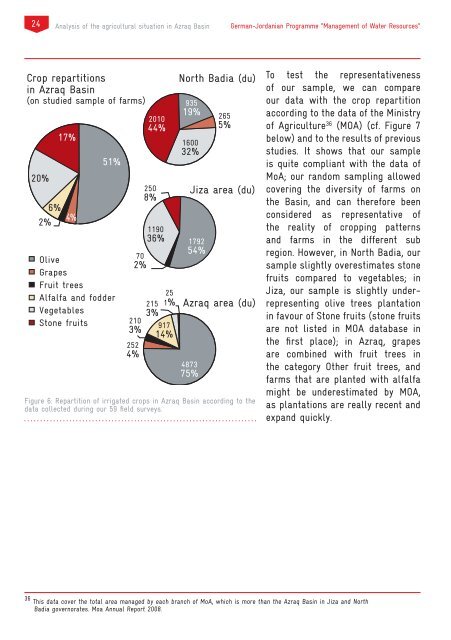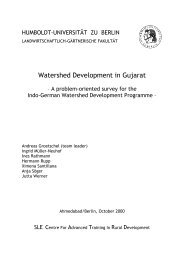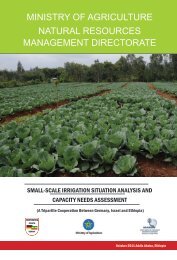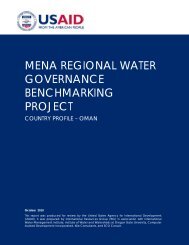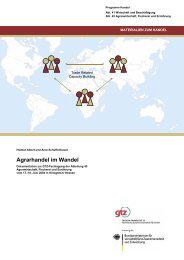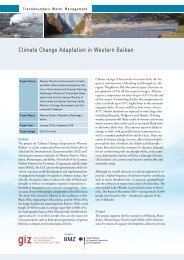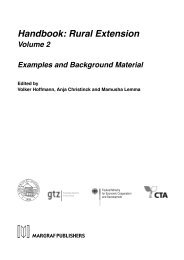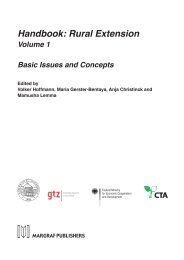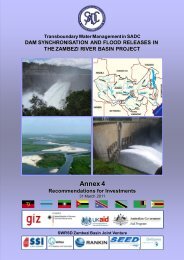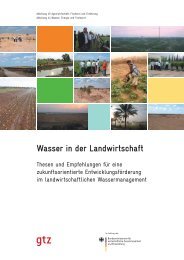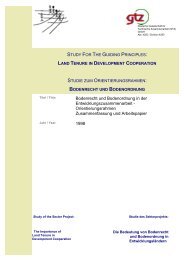Farming in the - WordPress.com
Farming in the - WordPress.com
Farming in the - WordPress.com
You also want an ePaper? Increase the reach of your titles
YUMPU automatically turns print PDFs into web optimized ePapers that Google loves.
24<br />
Analysis of <strong>the</strong> agricultural situation <strong>in</strong> Azraq Bas<strong>in</strong><br />
German-Jordanian Programme “Management of Water Resources”<br />
Crop repartitions<br />
<strong>in</strong> Azraq Bas<strong>in</strong><br />
(on studied sample of farms)<br />
20%<br />
17%<br />
51%<br />
6%<br />
4%<br />
Olive<br />
Grapes<br />
Fruit trees<br />
Alfalfa and fodder<br />
Vegetables<br />
Stone fruits<br />
250<br />
8%<br />
1190<br />
36% 1792<br />
54%<br />
70<br />
2%<br />
210<br />
3%<br />
252<br />
4%<br />
2010<br />
44%<br />
215<br />
3%<br />
25<br />
1%<br />
917<br />
14%<br />
North Badia (du)<br />
935<br />
19%<br />
1600<br />
32%<br />
265<br />
5%<br />
Jiza area (du)<br />
Azraq area (du)<br />
4873<br />
75%<br />
Figure 6: Repartition of irrigated crops <strong>in</strong> Azraq Bas<strong>in</strong> accord<strong>in</strong>g to <strong>the</strong><br />
data collected dur<strong>in</strong>g our 59 field surveys.<br />
To test <strong>the</strong> representativeness<br />
of our sample, we can <strong>com</strong>pare<br />
our data with <strong>the</strong> crop repartition<br />
accord<strong>in</strong>g to <strong>the</strong> data of <strong>the</strong> M<strong>in</strong>istry<br />
of Agriculture 36 (MOA) (cf. Figure 7<br />
below) and to <strong>the</strong> results of previous<br />
studies. It shows that our sample<br />
is quite <strong>com</strong>pliant with <strong>the</strong> data of<br />
MoA; our random sampl<strong>in</strong>g allowed<br />
cover<strong>in</strong>g <strong>the</strong> diversity of farms on<br />
<strong>the</strong> Bas<strong>in</strong>, and can <strong>the</strong>refore been<br />
considered as representative of<br />
<strong>the</strong> reality of cropp<strong>in</strong>g patterns<br />
and farms <strong>in</strong> <strong>the</strong> different sub<br />
region. However, <strong>in</strong> North Badia, our<br />
sample slightly overestimates stone<br />
fruits <strong>com</strong>pared to vegetables; <strong>in</strong><br />
Jiza, our sample is slightly underrepresent<strong>in</strong>g<br />
olive trees plantation<br />
<strong>in</strong> favour of Stone fruits (stone fruits<br />
are not listed <strong>in</strong> MOA database <strong>in</strong><br />
<strong>the</strong> first place); <strong>in</strong> Azraq, grapes<br />
are <strong>com</strong>b<strong>in</strong>ed with fruit trees <strong>in</strong><br />
<strong>the</strong> category O<strong>the</strong>r fruit trees, and<br />
farms that are planted with alfalfa<br />
might be underestimated by MOA,<br />
as plantations are really recent and<br />
expand quickly.<br />
36 This data cover <strong>the</strong> total area managed by each branch of MoA, which is more than <strong>the</strong> Azraq Bas<strong>in</strong> <strong>in</strong> Jiza and North<br />
Badia governorates. Moa Annual Report 2008.


